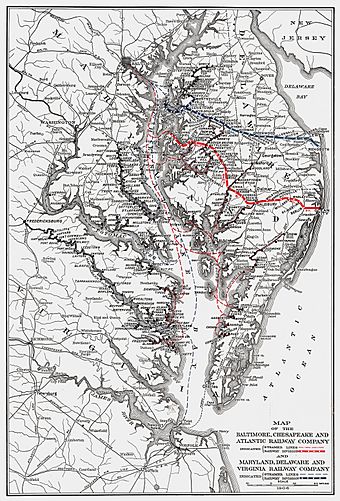Baltimore, Chesapeake and Atlantic Railway facts for kids

1906 Map
|
|
| Overview | |
|---|---|
| Headquarters | Baltimore, Maryland |
| Locale | Maryland, United States |
| Dates of operation | 1894–1928 |
| Predecessor | Baltimore and Eastern Shore Railroad Wicomico and Pokomoke Railroad Worcester Railroad |
| Successor | Baltimore and Eastern Railroad Company |
| Technical | |
| Track gauge | 4 ft 8 1⁄2 in (1,435 mm) standard gauge |
| Electrification | No |
| Length | 87 miles (140 km) |
The Baltimore, Chesapeake and Atlantic railroad, often called Black Cinders & Ashes, was a railway line in Maryland. It connected Claiborne, Maryland to Ocean City, Maryland. From Claiborne, people could take steamships across the Chesapeake Bay to Baltimore. The railroad covered about 87 miles (140 km) of main track.
This railroad also played an important part in the fight against racial segregation. This was a time when laws, called Jim Crow laws, kept Black and white people separated. Civil rights leaders like William Ashbie Hawkins challenged these unfair rules on the trains and boats. Even though his early efforts didn't fully succeed, they helped pave the way for future changes.
Contents
A Journey Through Time: The Railroad's History
The Baltimore, Chesapeake and Atlantic (BC&A) railroad had a long and interesting past. It started from earlier railway companies that joined together.
Early Beginnings: The Baltimore & Eastern Shore Railroad
The idea for this railroad began in 1876 as the Baltimore & Eastern Shore Railroad Company. It was officially started in 1886. The goal was to keep trade between Baltimore and the Eastern Shore of Maryland strong. Businessmen from Easton, Maryland helped organize it.
Construction began in 1889. By December 1, 1890, the main line was finished. This railroad also bought the Wicomico & Pocomoke Railroad. That line ran from Salisbury to Ocean City. The Baltimore & Eastern Shore also ran a ferry from Claiborne to Annapolis. From Annapolis, trains connected to Baltimore.
Becoming the Baltimore, Chesapeake and Atlantic
The Baltimore & Eastern Shore Railroad didn't do well financially. So, in 1894, it was sold and reorganized. This new company was named the Baltimore, Chesapeake and Atlantic railroad (BC&A). Its main office was in Salisbury, Maryland.
In the same year, the BC&A also bought several steamboat companies. This meant they controlled both train and boat travel. In 1902, the Pennsylvania Railroad bought most of the BC&A's shares. However, the BC&A still ran as its own company.
By 1915, the BC&A had about 87 miles of track. It also had extra tracks for storing trains. For a while, the railroad and steamboat services made good money. But after 1912, they stopped paying dividends to their investors.
Challenges and Changes
By 1921, the railroad started losing money. More people were using cars and trucks. This made it harder for the railroad to compete. The Pennsylvania Railroad had to help the BC&A financially.
In 1926, the Pennsylvania Railroad decided it would no longer help. The BC&A faced serious money problems. In 1928, the railroad was sold again. It was then reorganized as the Baltimore and Eastern Railroad. This new company was fully owned by the Pennsylvania Railroad.
The Baltimore and Eastern Railroad and Beyond
The Baltimore and Eastern Railroad continued to operate. It offered passenger service to many towns, including Ocean City and Salisbury. However, passenger service ended by 1938.
The railroad survived through big changes in the railway industry. Eventually, in 1982, the State of Maryland bought parts of the old Baltimore and Eastern Shore and BC&A lines. Today, the Maryland Department of Transportation still owns these segments.
Fighting for Fairness: Civil Rights on the Railroad
The Baltimore, Chesapeake and Atlantic railroad played a role in the fight for civil rights. In the early 1900s, Maryland had "Jim Crow" laws. These laws enforced racial segregation. This meant Black and white people were kept separate on trains and boats.
Challenging Segregation
In 1910, Maryland created the Maryland Public Service Commission. This group oversaw transportation companies. Soon after, a brave lawyer named William Ashbie Hawkins began to challenge the BC&A. He filed complaints against the railroad for its unfair practices.
- In December 1911, Hawkins sued the BC&A. He said their ferryboats, the Avalon and the Joppa, discriminated against Black passengers. He claimed Black passengers were forced into small, poorly ventilated cabins. They could only eat food left over after white passengers had finished. He also said Black ministers and their wives were forced to sit in a salon all night because they couldn't get proper rooms.
- Hawkins sued the BC&A again. This time, a school teacher named Thomas Turner complained. He said Black passengers could only ride in a small area near the smoking section for white men.
Even though Hawkins' complaints were not fully successful at the time, they made a difference. The Public Service Commission suggested changes. They ordered the BC&A to provide equal seating for all passengers. This included adding partitions in non-smoking and smoking cars.
A Step Towards Equality
It took many more years for full equality to be achieved. In 1950, another Marylander, Elmer Henderson, won a major case in the United States Supreme Court. He argued that segregated dining on railroads was unfair.
The court agreed that separating passengers in dining cars was against the law. This victory helped end segregation in interstate travel. Maryland then repealed its railroad segregation laws in 1951.
The efforts of people like William Ashbie Hawkins and Elmer Henderson were very important. They helped create a path for future civil rights leaders. Their work in Maryland helped make it possible for people like Rosa Parks to change the world.
Images for kids





